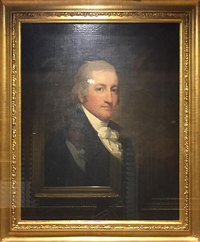John Tayloe III | |
|---|---|
 John Tayloe III by Gilbert Stuart on display at the Metropolitan Museum of Art | |
| Member of the Virginia House of Delegates for Richmond County, Virginia | |
| In office 1793–1794 Serving with Walker Tomlin | |
| Preceded by | Robert Mitchell |
| Succeeded by | position abolished |
| Member of the Virginia Senate for Lancaster, Richmond and Northumberland Counties | |
| In office 1798–1802 | |
| Preceded by | Joseph Chinn Sr. |
| Succeeded by | Walter Jones |
| Personal details | |
| Born | September 2, 1770 Mount Airy, Richmond County, Virginia |
| Died | March 23, 1828 (aged 57) Mount Airy, Richmond County, Virginia |
| Nationality | British/American |
| Spouse | Ann Ogle (m. 1792) |
| Children | 15, including Benjamin, William, Edward, George, and Henry |
| Relatives | William Tayloe (planter) (great-great-granduncle) William Tayloe (the nephew) (great-grandfather) John Tayloe I (paternal grandfather) John Tayloe II (father) Benjamin Ogle (father-in-law) |
| Education | Eton College, Cambridge University |
| Occupation | Planter, agent |
| Known for | Virginia Planter, Builder of The Octagon House, Founder of the Washington Jockey Club, Founder St. John's Episcopal Church, Lafayette Square |
Col. John Tayloe III (September 2, 1770 – March 23, 1828), of Richmond County, Virginia, was the premier Virginia planter[1] and scion of the tidewater gentry. Although his father and grandfather had served on the Virginia governor's council and were staunch proponents of British Colonial Rule, Tayloe like his father later, sided with the patriots in the American Revolution then served in both houses of the Virginia General Assembly.[2] A successful planter, capitalist, banker, director, and early Thoroughbred breeder/importer, he was considered the "wealthiest man of his day".[3]
The Tayloe family of Richmond County, including his father, John Tayloe II, and grandfather, John Tayloe I, exemplified gentry entrepreneurship by the diversifying business interests utilizing agriculture to begin vertically integrating their supply chain including shipbuilding and iron production to satisfy transportation needs.[4]
- ^ John Venn and John A. Venn, Alumni Cantabrigienses: A Biographical List of All Known Students, Graduates and Holders of Office at the University of Cambridge, from the Earliest Times to 1900 [1922–54], pt. 2, 6:119; Leonard, General Assembly; MB, 2:1235; Charles M. Harris and Daniel Preston, eds., Papers of William Thornton [1995– ], 1:492, 576–8, 584–8; Orlando Ridout, Building the Octagon [1989]; Madison, Papers, Pres. Ser., 4:240–1; Wilhelmus Bogart Bryan, A History of the National Capital: From its Foundation through the Period of the Adoption of the Organic Act [1914–16], 1:304, 609; Wesley E. Pippenger, comp., District of Columbia Probate Records: Will Books 1 through 6 1801–1852 and Estate Files 1801–1852 [1996; repr. 2003], 143–4; Richmond Enquirer, 7 Mar. 1828
- ^ Cynthia Miller Leonard, The Virginia General Assembly 1619-1978 (Richmond: Virginia State Library 1978) pp. 193, 214, 218, 222, 226
- ^ Cite error: The named reference
Hardy1911was invoked but never defined (see the help page). - ^ Kamoie, Laura Croghan (March 2008). "The Business History of the Virginia Gentry". p. 3. Retrieved October 19, 2011.
